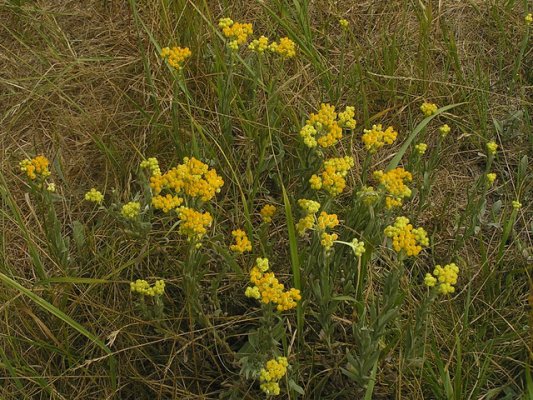Nominees of the Year: the Dwarf Everlast and the Tree Climacium Moss
The New Year has come with new challenges and new heroes - also in nature. As reported before, the Latvian Dendrologist Society has chosen the Scots pine (Pinus sylvestris) as the tree of the year 2017. The Latvian Botanical Society has now also selected its annual nominees: the plant of the year - the Dwarf Everlast (Helichrysum arenarium), which is also known as the Golden Everlast; and the moss of the year - the Tree Climacium Moss (Climacium dendroides), the surface part of which looks like a small tree.
The Dwarf Everlast - a plant with yellow, soft and friendly-looking blossoms
Foto: naturgucker.de
The Dwarf Everlast is a perennial small plant that blooms with bright yellow or orange blossoms. In Latvia, it can mostly been seen in the south-east regions of the country. It grows in dry, sunny edges of forests or meadows, along roadsides, and is often to be found in dry pine forests. The dense, silky white hair on the leaves and stem help the plant to retain moisture; it reflects sunlight, thus reducing the temperature on the leaves and the evaporation of water.
The Dwarf Everlast has a broad range of application, but unfortunately it can be seen in nature more and more rarely; it is included in a number of lists of plants to be protected and the use of which must be restricted, also in our neighbouring countries - Lithuania and Estonia. "The species has weak competitive ability, so as the soil becomes richer and other species multiply, the Dwarf Everlast is forced to give up," says Ilze Rēriha, LVM Environmental Expert, adding that anyone can try to sow the Dwarf Everlast seeds in a sandy or gravelly edge of a garden. It may work!
The commonly found Tree Climacium Moss
The Latvian moss flora is relatively rich in species: it includes more than 500 species. It is the second year that the moss of the year is also selected. The ostrich-plume feathermoss was last year chosen as the moss of the year, but this year it is the Tree Climacium Moss (Climacium dendroides).
The largest share of Latvian mosses dwell in forests. Also the Tree Climacium Moss likes forests, but not only. Wet, light areas are the most suitable environment for this plant; however, it is also able to grow in the grey dunes. Usually the Tree Climacium Moss forms dense turfs or even small hummocks, but it can also hide among other mosses.
"In my opinion, the Tree Climacium Moss is unique with its wide adaptability to different growing conditions: from black alder swamps to dune habitats, from flooded meadows to dry grazed grassland; it grows along springs on windfallen trees and stones. These species of moss can be found all around us," says Ilze Rēriha, LVM Environmental Expert.
The Tree Climacium Moss belongs to the leaf moss class. It is the only representative of its genus in Latvia, therefore it is relatively difficult to mix it up with any other plant. The name of the Tree Climacium Moss has been given to the plant because its surface parts resemble small, yellow-green or green trees. Thanks to this similarity, it is very easy to recognise the Tree Climacium Moss.
The primary stem of the Tree Climacium Moss lies horizontally in the soil and is covered with brown, glume-type leaves. It has steep secondary stems branching in the middle section of the stem. The branches are up to 4 cm in length, located close to one another; therefore they look as if they form a small bouquet, like a small palmtree. The dark green or yellow-green turfs of the Tree Climacium Moss can reach up to 10 cm in height.



